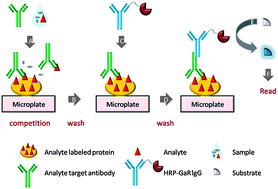A sensitive and specific enzyme immunoassay for detecting tartrazine in human urinary samples
Abstract
Tartrazine is commonly used in foodstuffs, its level is controlled by government, however, it is still used in some food products at levels which are not permitted. We aimed to develop a sensitive and simple method to assess the exposure to tartrazine in pregnant women and the general population in China. A competitive enzyme-linked immunosorbent assay (ELISA) was developed based on polyclonal antibodies for tartrazine. Using this assay, we measured the urinary concentrations of tartrazine in the participants. Under optimal experimental conditions, the standard curve was constructed at concentrations of 0.04–1000 ng mL−1 and the limit of detection (LOD) was set at 0.04 ng mL−1. No cross-reactivity of the antibody was observed with seven other artificial dyes based on this assay. Human blank urine was spiked with tartrazine at concentrations of 0.1, 25, 500 ng mL−1 and analyzed by ELISA, the recoveries of tartrazine were from 99.8% to 106.6% and coefficients of variation were from 3.28% to 14.9%. The study comprised of 351 volunteers (age: 19–69 years), of which 30% were male, 16% were nonpregnant women and 54% were pregnant women. The geometric means for tartrazine in three groups were 2.64, 2.44 and 3.21, respectively. No difference was observed in these groups. The values indicated that both the general population and pregnant women are exposed to tartrazine. Sources of exposure, potential health effects and risk assessment require further investigation.


 Please wait while we load your content...
Please wait while we load your content...